Japan Wood Products
Prices
Dollar Exchange Rates of
20th November
2013
Japan Yen
100.02
Reports From Japan
Assessment of the current state of the Japanese
economy
The Japanese Cabinet Office has released its latest
assessment of the current state of the Japanese economy
saying the recovery is proceeding at a moderate pace
despite some weakness in exports. The full press release
can be found at: www5.cao.go.jp/keizai3/getsureie/
2013nov.html
In summary the latest report says:
Industrial production is increasing at a moderate
pace
Corporate profits continue to improve mainly
among large firms
Business investment is picking up, mainly among
non-manufacturing industries
The judgment of firms on current business
conditions is further improving
The employment situation is improving
Private consumption is on an upward trend
Recent price developments suggest that deflation
is ending
In the short term, says the report, the recovery is expected
to consolidate as household income and business
investment continue to improve. A last-minute rise in
consumption is expected as consumers buy items in
advance of the consumption tax increase however, weak
overseas demand is still a risk.
Consumption and investment
Real GDP in the July - September quarter of 2013
increased by 0.5% on a quarterly basis (equivalent to an
annual rate of 1.9%), this was the fourth consecutive
quarter of growth.
Private consumption is said to be picking up and although
consumer confidence has weakened recently, real
household incomes are said to have held firm. Recent
demand-side statistics, including the Family Income and
Expenditure Survey, point to an improvement in
sentiment.
Quarterly financial statements from large corporations
show that investment increased in the April-June quarter
by 2.9% from the previous quarter, the third consecutive
quarter of increase. However, investment by
manufacturers fell by 0.6% from the previous quarter but
for non-manufacturers investment grew by 4.7% from the
previous quarter.
According to the Business Outlook Survey by the Ministry
of Finance and the Cabinet Office, planned business
investment in fiscal year 2013 is expected to increase both
for large manufacturers and large non-manufacturers. The
figures for Orders Received for Machinery, a leading
indicator, have improved.
Consumer confidence undermined
Japan‟s economy is showing steady signs of growth and
the efforts to fight deflation seem to be having an impact
as the government data shows consumer prices (excluding
food and energy)rose in October however, household
spending remains subdued.
The government and BoJ have a 2% inflation target to be
achieved over the next two years. Analysts say most of the
current consumer price increases are the result of the
weaker yen which has driven up the cost of imported
items, notably fuel for power generation and petrol. The
higher cost of these items has spilled over into higher
household costs.
In Japan household spending accounts for over 60% of the
country‟s economic activity but spending has fallen for
two months in a row. The rising cost of living and stagnant
incomes is undermining consumer confidence.
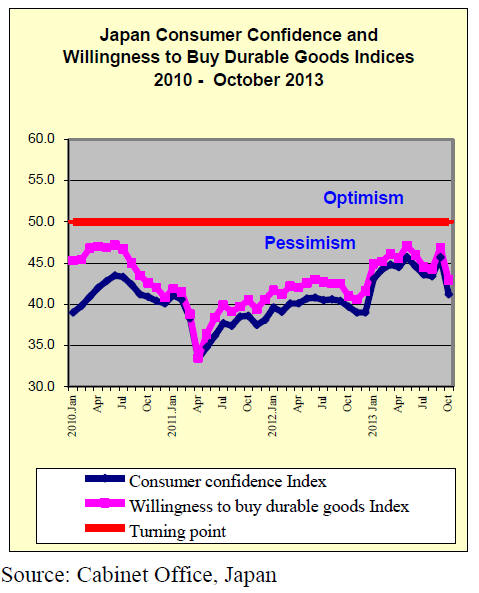
Monetary policy begins to turn around deflationary
trend
Economic indicators released by Japan suggest that the
monetary policy and stimulus strategy of the government
and Bank of Japan (BoJ) are beginning to impact
deflation. for the world's No. 3 economy.
Japan has not had experienced inflation since October
2008 because there has been virtually no economic
growth. The Bank of Japan has set its self a target of two
per cent inflation. By mid 2014.
The government reported that, excluding food, the
consumer price index rose almost 1% from a year earlier
but much of this could be the result of the steep jump in
electricity prices introduced after the nuclear power plants
were shut down after the Fukushima nuclear disaster.
Household spending in Japan remains weak mainly
because consumers do not have confidence that they will
benefit from current economic policies and because
employment situation is tough. In the face of rising
inflation and stagnant incomes short term prospects are not
bright.
Yen drops to below 100 to the US dollar
The sharp decline in the yen exchange rate to below yen
100 to the US dollar resulted in a boost to the value of the
Japanese stock market which is dominated by export
companies.
Japan's exporters will be the biggest beneficiaries of the
yen's weakness, as consumers overseas with dollars will
find Japanese imports cheaper.
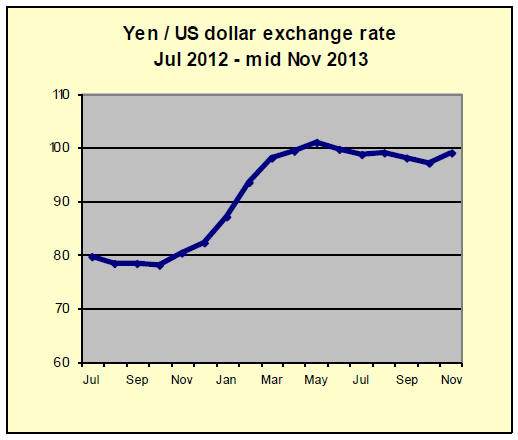
Good short term prospects in housing sector
Housing construction has been increasing in recent months
the result of a last-minute rise in demand before a
consumption tax increase. Construction of privately owned
houses, houses for rent and houses for sale have all
increased. Also, the total number of sales of
condominiums in the Tokyo metropolitan area has been
increasing.
The short-term prospects for housing construction is good,
supported by the improvement of the employment and
income situations and a last-minute rise in demand before
a consumption tax increase.
However, the availability of skilled construction workers
may become a constraint on further growth in housing
starts.
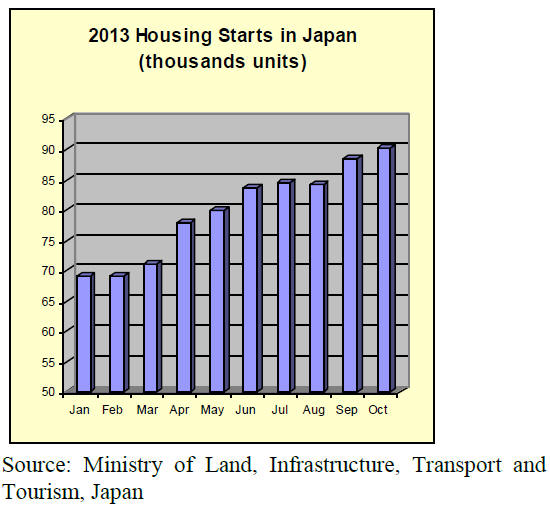
Trade news from the Japan Lumber Reports (JLR)
The Japan Lumber Reports (JLR), a subscription trade
journal published every two weeks in English, is
generously allowing the ITTO Tropical Timber Market
Report to extract and reproduce news on the Japanese
market.
The JLR requires that ITTO reproduces newsworthy text
exactly as it appears in their publication.
For the JLR report please see:
http://www.nmokuzai.
com/modules/general/index.php?id=7
Soaring prices of domestic logs
Domestic log prices have been inflating rapidly by busy
orders sawmills and plywood mills as a result of booming
housing starts before consumption tax increase.
Log supply is way behind swelling demand so that log
prices are soaring everywhere in Japan. With higher log
prices, lumber market prices are also firming.
In Kyushu and Shikoku, prices of sill cutting cypress logs
exceed 28,000 yen per cbm. In Tochigi, post cutting cedar
log prices shot up to 15,800 yen, 1,500 yen up from
September prices and sill cutting cypress log prices
jumped up to 30,700 per cbm yen, 4,100 yen up from
September.
Compared to the bottom prices in last June, they are 5,300
yen or 50.5% higher and 10,300 yen or 50.5% up.
Compared to the recent low prices in May through July
last year, they are 81.6% up and 98.1% up.
South Sea (tropical) plywood market bottoming out
Market of South Sea hardwood plywood is bottoming both
in supplying regions and in Japan.
In Tokyo market, where the demand should be better than
other areas after Tokyo is selected as the Olympic game in
2020 but weakness remains in November.
Dumping sales by the importers and wholesalers started in
mid August to dispose of excessive inventories and peaked
in late September in time for book closing then the
aftereffect lingered into October.
Market undertone remained unsteady even in November
when the importers sold under the cost of future cargoes to
DIY stores and wholesalers. Finally low priced offers
disappeared in mid November.
Shipping volume from the port yards was the bottom in
August then they have kept increasing and October
shipment was the same as the peak month of this year.
Arrivals of concrete forming panel have been declining
since June.
By heavy arrivals and weakening yen, many reduced
future purchases so finally supply and demand are
balancing.
General forecast is the supply of 3x6 concrete forming for
coating would get tight by late November and of green
3x6 concrete forming by late December.
Producing regions are partially in rainy season and India is
aggressively purchasing. After major suppliers built up
order files then the export prices bottomed out, other
suppliers get aggressive and their attitude is rigid now.
Japanese buyers are puzzling to see if they should buy
futures after lengthy market slump but considering
dropping inventories in Japan and rush-in demand before
the tax raise, it is necessary to buy futures now.
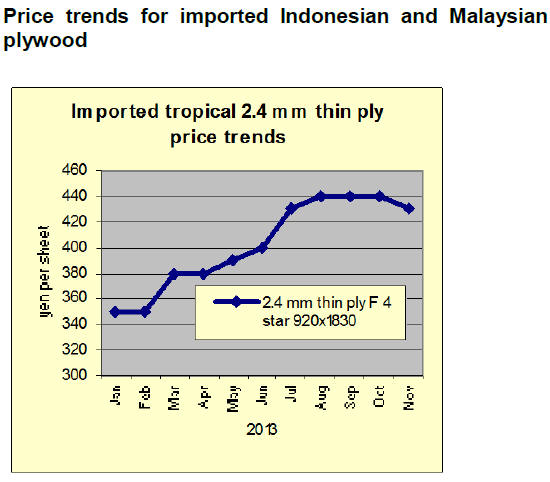 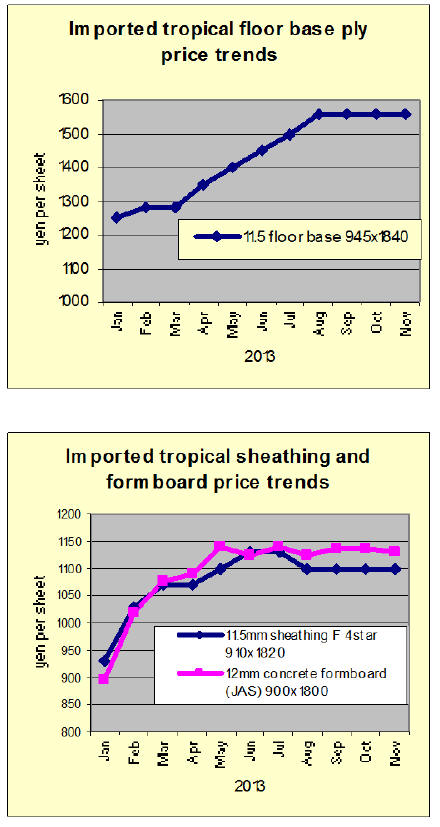
October 2013 furniture imports
The source and value of Japan‟s office, kitchen and
bedroom furniture imports for October 2013 are shown
below. Also illustrated is the trend in imports of office
furniture (HS 9403.30), kitchen furniture (HS 9403.40)
and bedroom furniture (HS 9403.50) between 2009 and
October 2013.
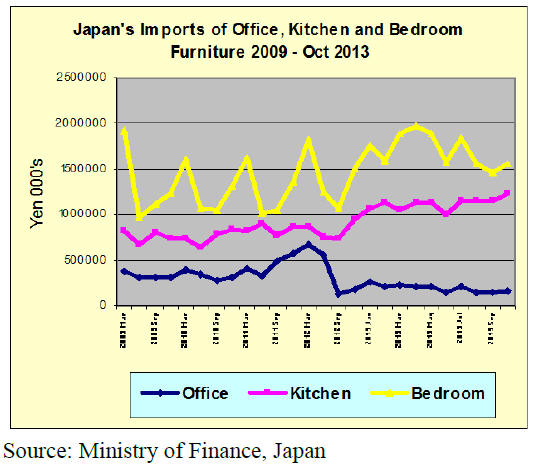
Office furniture imports (HS 9403.30)
In October 2013 Japan‟s imports of office furniture
increased by around 13% from levels in September The
top supplier was China which provided 52% of all office
furniture in October. Other main suppliers were Italy
(7.7%) and Germany (6.5%).
Office furniture exporters in Asia provided some 66% of
Japan‟s imports of this category of furniture in October
and China‟s share of imports in October rose to 22%.
October imports from Germany were also up on levels in
September rising 5 fold.
However, the value of imports from Germany was very
modest compared to the value of imports from China.
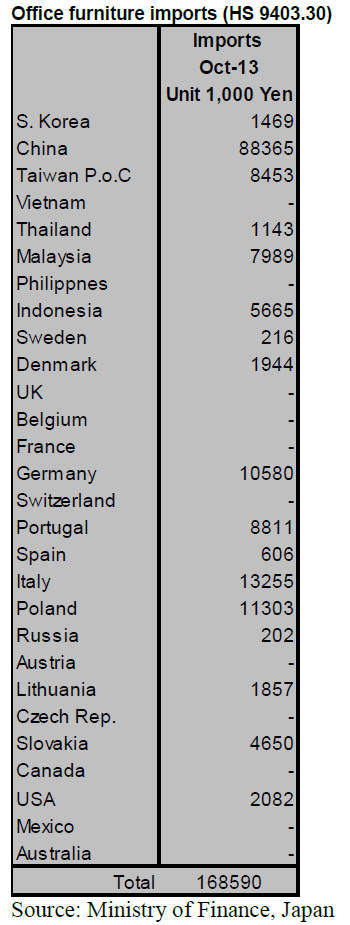
Kitchen furniture imports (HS 9403.40)
Asian suppliers continue to supply the bulk of the kitchen
furniture imports by Japan. According to figures from
Japan‟s Ministry of Finance. October kitchen furniture
imports, at yen 1,229 mil. were up slightly on levels in
September (yen 1,152). Overall, suppliers in Asia
provided 89% of Japan‟s kitchen furniture in October.
The top supplier in October was Vietnam, by a huge
margin. Vietnam has maintained its position as number
one supplier for the year to-data. In a reversal of ranking
Indonesia bcame the second ranked supplier pushing the
Philippines into number three position.
It is worth noting that Japan‟s imports of kitchen furniture
in October were more than the combined imports from
Indonesia and Philippines.
Of the non-Asian suppliers the US was the largest
contributor to imports of kitchen furniture in October but
could only secure a 2.4% share of imports of this category
of furniture. The EU supplier around 2.5% of Japan‟s
kitchen furniture imports in October with Germany being
the main source.
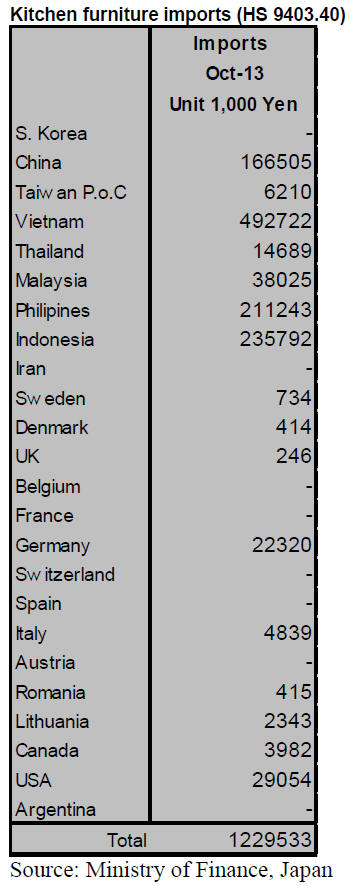
Bedroom furniture (HS 9403.50)
Japan‟s October imports of bedroom furniture rose to yen
1,557 mil. in October, up on the yen 1,465 mil. in
September but not too much should be read into this
change as monthly imports of bedroom furniture swing
from peaks to dips as illustrated in the graph above.
China‟s October exports of bedroom furniture to Japan
accounted for 54% of Japan‟s total imports of bedroom
furniture in the month. Asian suppliers, once more,
provided the bulk of the bedroom furniture imports
accounting for 88% of all bedroom furniture.
Bedroom furniture imports are almost 30% higher than
imports of kitchen furniture and som nine times more than
office furniture imports

|